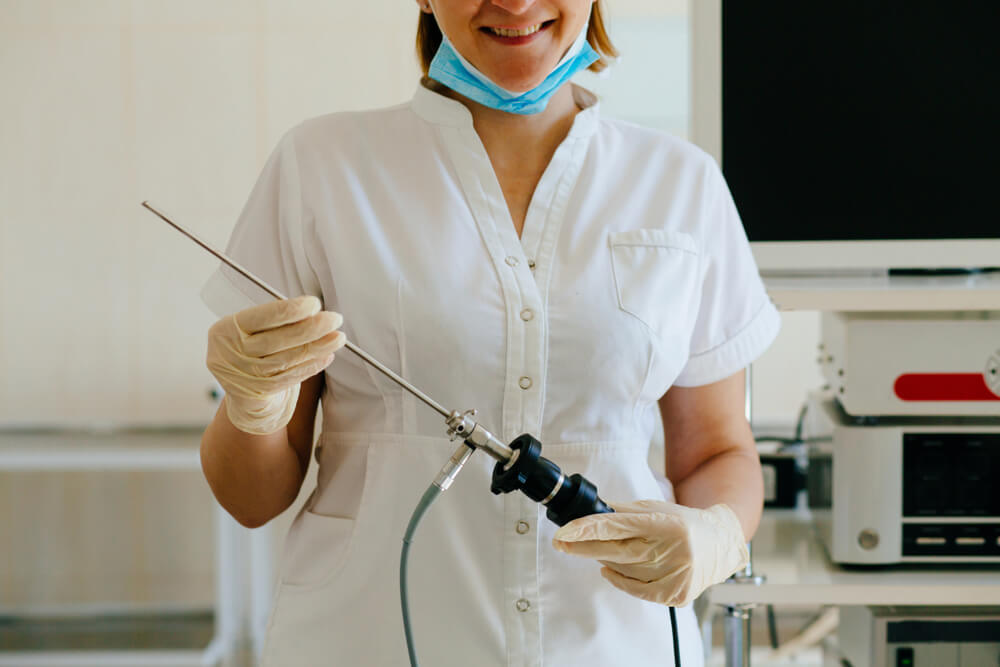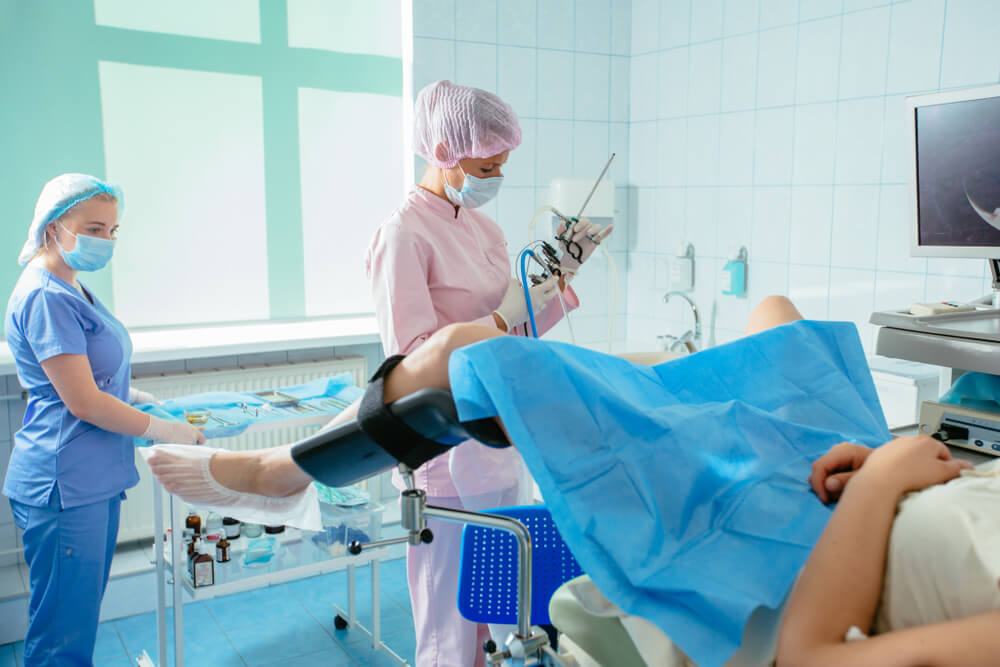A healthcare provider may have told you that you or a loved one needs a hysteroscopy, and now you’re scouring the internet searching for answers to your questions. Like, “What is a hysteroscopy?”, “What happens during the procedure?”, “How long does a hysteroscopy take?” or “How long will recovery from hysteroscopy be?”
You’ve come to the right place! At New Age Women’s Health, gynecology specialists in Miami are glad to share our expertise. We’ll help you make informed decisions and set your mind at ease.
What Is Hysteroscopy?
To define the word, we need simply to examine its parts. The prefix hyster- means womb/uterus, and -oscopy means to use a scope. Therefore, a hysteroscopy is a procedure to examine a woman’s uterus using a scope. A scope is a thin tube with a camera and a light attached in this context. This tube, called a hysteroscope, is then inserted into the vagina allowing the doctor to access both the cervix (the small canal connecting the vagina and uterus) and the uterus.
There are two types of hysteroscopy procedures, diagnostic and operative. One is used to diagnose problems with the cervix or uterus. Your provider may use it to find causes of abnormal bleeding, infertility, severe cramping, and more. The other treats conditions encountered during the diagnostic procedure. Your provider may also use it to remove fibroids (non-cancerous growths) and scar tissue or stop bleeding. Both approaches are performed the same way, with the only difference being added tools to the scope for the operative process.
Common Situations Involving a Hysteroscope

Your doctor may have recommended this procedure for several reasons. The top reason for hysteroscopy is longer or heavier periods than usual or bleeding between periods. In which case, the tools that can be attached to the scope come in handy if they find anything abnormal. They can simply take a sample of it for later testing.
That testing is another typical cause for the procedure. It’s called a biopsy. The evaluation is performed when fibroids, polyps, and scarring are detected through imaging.
Other frequent uses include:
- Abnormal results on your pap smear
- Diagnose the cause of repeated miscarriages or problems getting pregnant
- Bleeding after menopause
- Removal or adjusting the position of an IUD
- Blocking the fallopian tubes to prevent pregnancy (known as sterilization) permanently
- Diagnose thickening of the uterine lining (known as endometriosis)
What Happens During the Hysteroscopy Procedure
The hysteroscopy procedure may occur in a hospital or at the doctor’s office. Before beginning, the doctor will give you medication to either put you to sleep or relax you and prevent pain. At this point, medication or tools are used to dilate (open up) the cervix. A device called a speculum is then used to hold the vagina open.
Once fully prepped, the provider inserts the scope into the vagina, through the cervix, and into the uterus. Sometimes gas or fluid is pushed through the tube to expand the area and give a clearer view. The attached camera sends real-time video to examine or guide the operation for the doctor.
How Long Does a Hysteroscopy Take?
We’re sure you’re wondering, how long does a hysteroscopy take? Since it is a relatively simple procedure, it doesn’t take long to perform. Typically, from the moment the doctor inserts the hysteroscope, it takes about 15 minutes to an hour. Yet, it can possibly take as little as 5 minutes or be well over the hour mark.
The time frame depends mainly on why your doctor ordered the hysteroscopy in the first place. Operative procedures tend to be on the longer side. In contrast, diagnostic ones are usually much shorter. At times other things are being done at the same time. In these cases, you can expect to add the standard time of the accompanying process to that listed above.
Recovery from Hysteroscopy Procedure
Soon after completion, you will likely go home. When this happens depends on the type of medication used. If your doctor puts you to sleep, you can expect to spend more time in the hospital or office. Your provider will track your vital signs (blood pressure, pulse, breathing) as you wake and make sure you’re stable and alert before releasing you.
Regardless of whether or not you were awake, you’ll need someone to drive you home since you’ll be sore and still feeling the sedative effects of the medication.
Recovery from hysteroscopy is relatively short, with discomfort lasting for about 24 hours. You can expect to remain sore for a few days following the procedure. You will likely have some cramping and spotting (light bleeding). You may have gas in your digestive tract along with the gas used to expand the uterus. The gas may cause pain in your abdomen, upper belly, or shoulder.
Your provider may prescribe pain medication to help with recovery or recommend over-the-counter pain relievers. Please follow your doctor’s recommendations as some medicines can increase the chance of abnormal bleeding.
Your doctor will provide specific instructions based on your situation before going home. However, it is commonly recommended that you avoid vaginal sex for at least two weeks. Other than that, special care is not usually required, and you’re free to resume your normal activities and diet unless otherwise directed.
Risks and Benefits

Benefits
The main benefit of hysteroscopy is less invasive than other options. It provides the same results as open abdominal surgery without the need for an incision (a surgical cut). That means no need to care for a scar or follow-up appointments to remove stitches or staples.
Other advantages can include but are not limited to:
- Little to no recovery time
- Minimal need for pain medicine after release
- No overnight hospital stays
- No scar tissue
Risks
As with all medical procedures, there are risks involved as well. A hysteroscopy is relatively safe, especially when compared to open abdominal surgery. According to the Cleveland Clinic, complications occur in less than 1% of cases, which means less than 1 out of 100 patients experience problems.
The possibility of complications grows when your provider puts you to sleep for the procedure. The issues from anesthesia are usually mild, like nausea/vomiting, dizziness, or headache. These problems can be more severe at times, such as trouble breathing or a lung infection.
Common risks for any invasive procedure may include:
- Infection
- Bleeding
- Damage to nearby tissues
Complications of hysteroscopy may include:
- Pelvic inflammatory disease
- Severe Bleeding
- Reaction to fluid or gas used to expand the uterus
- Scarring inside the uterus
- Low sodium levels caused by liquid absorbed during the procedure
Infrequent problems associated with the procedure may include:
- Damage to the cervix
- Tearing of the uterus
- A hole through the uterine wall
- Damage to nearby organs, including your bladder, ovaries, and bowel
- Need for further surgery
- Blood clots (If they travel to the lungs, they can become deadly)
There may be other risk factors based on your unique condition, as with anything. We at New Age Women’s Health are always here to help. We treat all of our patients like family and can’t wait to welcome you home! Don’t be afraid to contact us and discuss any concerns before undergoing the procedure.





